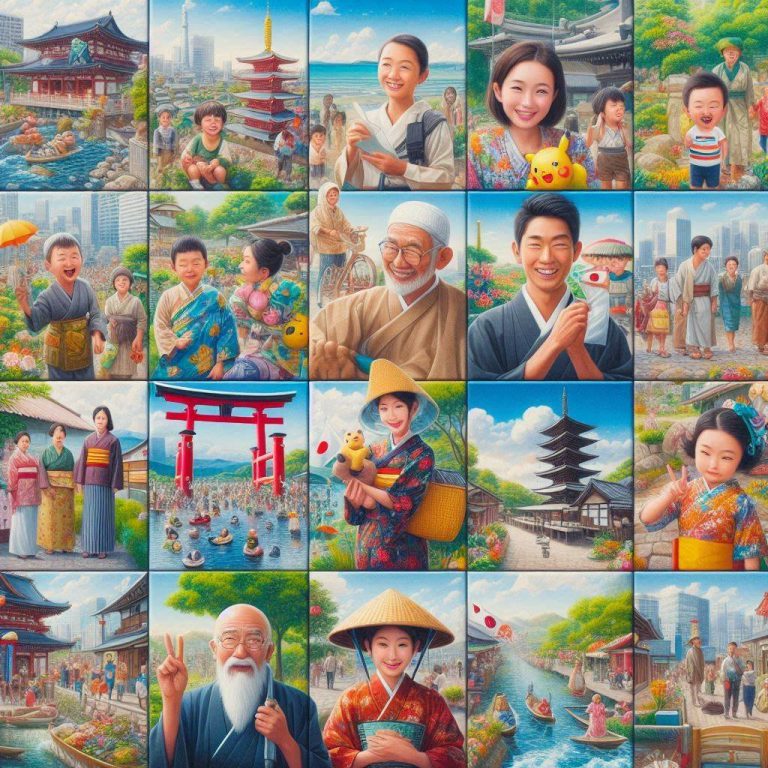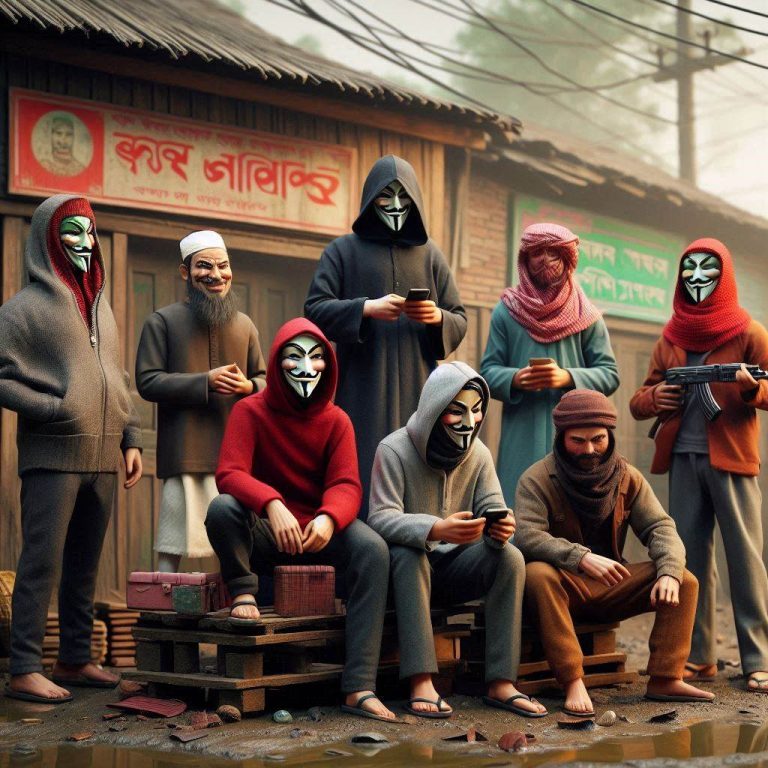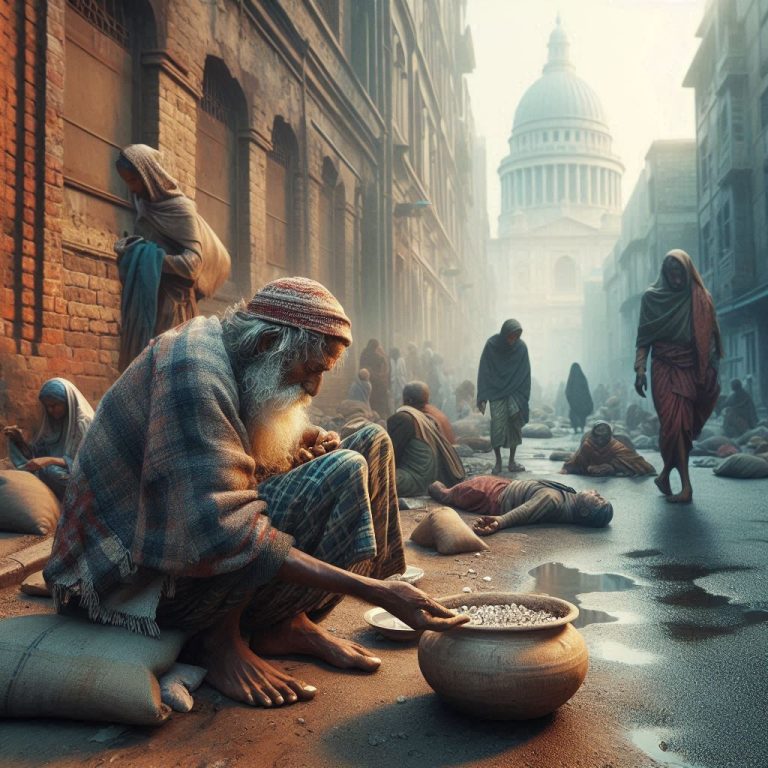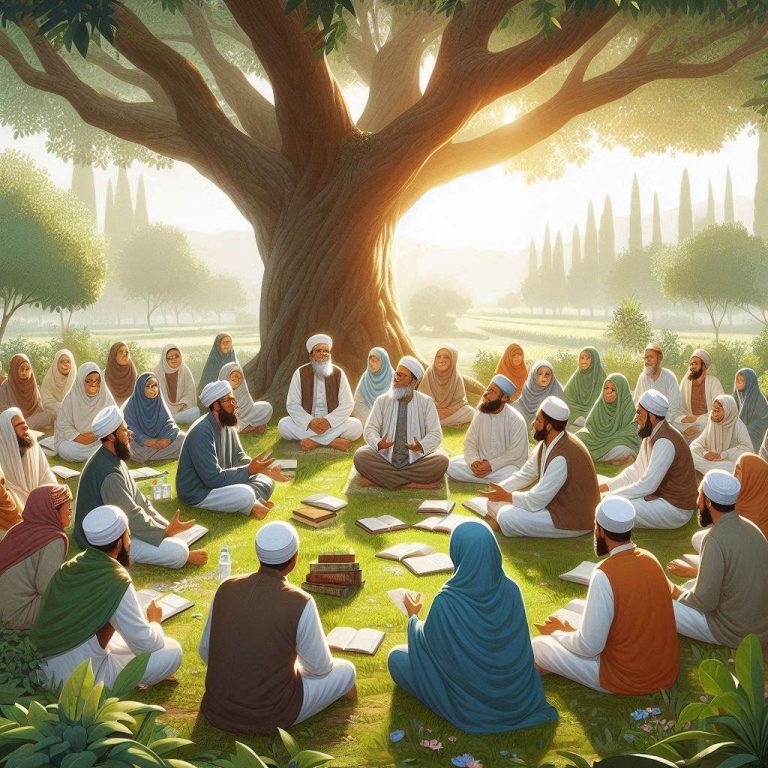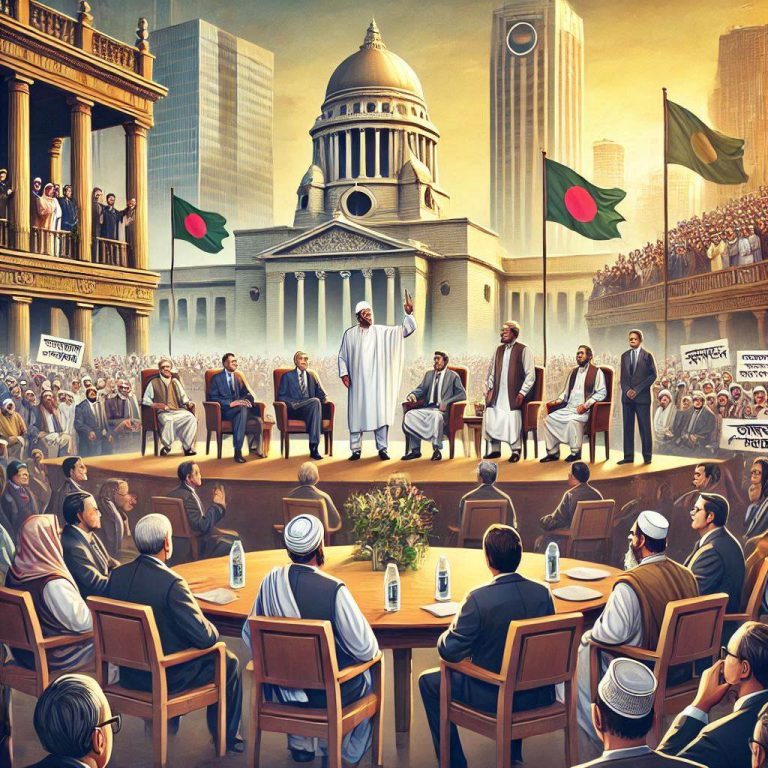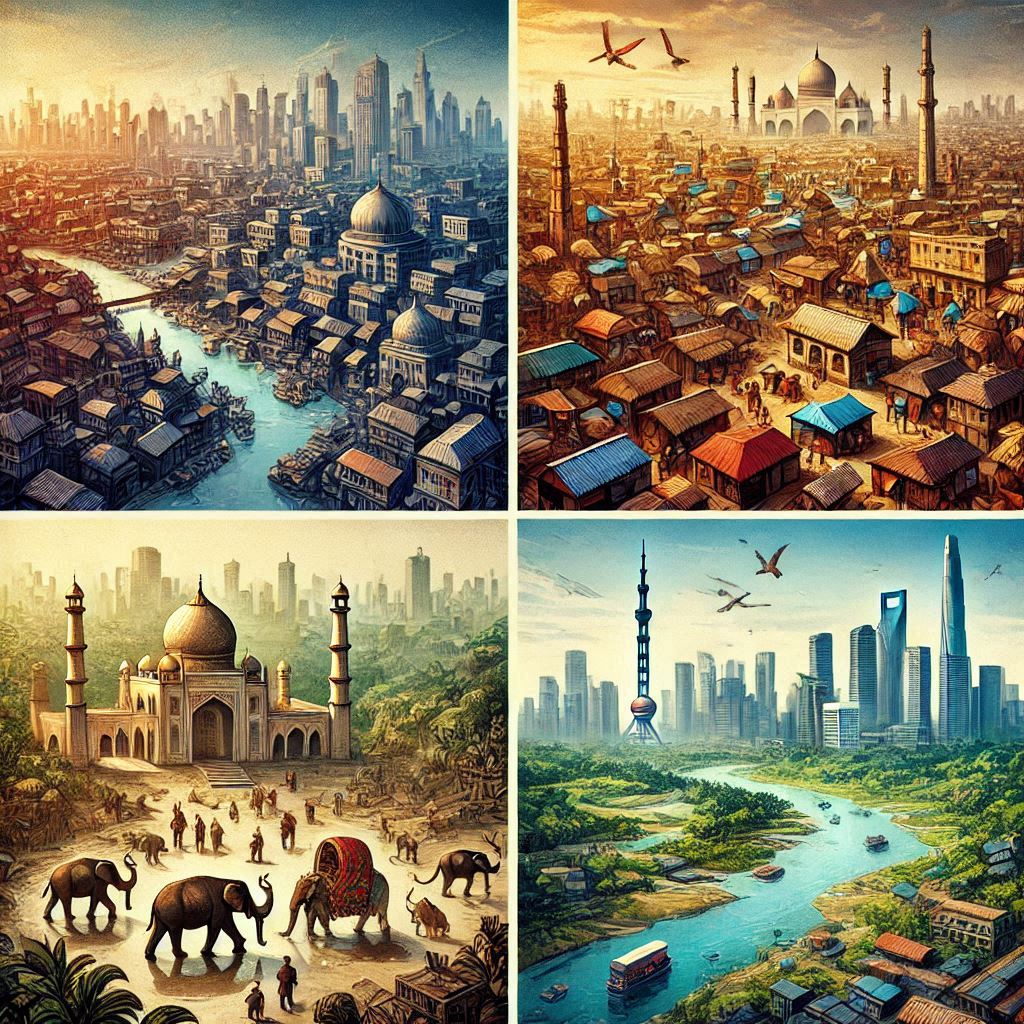
Introduction.
Bangladesh, a country renowned for its lush greenery, intricate waterways, and cultural diversity, is a land of contrasts and vibrancy. The nation is divided into eight administrative divisions, each containing numerous districts, upazilas (sub-districts), unions, and ultimately, villages. This intricate administrative structure facilitates governance and development across both urban and rural areas. The landscape of Bangladesh is dotted with bustling cities, historic towns, and serene villages, each with its own story and significance. This article provides an extensive overview of these settlements, offering insights into their development, cultural heritage, and role in the national fabric.
Cities Governed by City Corporations:
The major cities in Bangladesh are governed by City Corporations, which are responsible for urban planning, infrastructure development, and public services. These cities are the economic, cultural, and political hubs of the country.
Dhaka:
The capital city, Dhaka, is the heart of Bangladesh, both geographically and economically. With a population exceeding 21 million, it is one of the most densely populated cities in the world. Dhaka’s rapid urbanization has made it a melting pot of cultures and ethnicities. The city is known for its vibrant markets, historical landmarks such as the Lalbagh Fort, and modern skyscrapers. As the political and economic center of Bangladesh, Dhaka hosts numerous government institutions, multinational corporations, and educational establishments like Dhaka University.
Chittagong:
Chittagong, the largest seaport city, plays a vital role in Bangladesh’s economy. The Chittagong Port is a major hub for international trade, handling around 90% of the country’s exports and imports. Chittagong is also known for its scenic hills, such as the Batali Hill, and beautiful beaches, including Patenga Beach. The city’s rich history is reflected in sites like the Zia Memorial Museum and the World War II Cemetery. Industrially, Chittagong is home to many factories and shipyards, contributing significantly to the national economy.
Khulna:
Located in the southwestern part of the country, Khulna is known for its industrial base and proximity to the Sundarbans, the world’s largest mangrove forest. The city is a key player in the jute, fish processing, and shipbuilding industries. Attractions in Khulna include the Khulna University, the Khan Jahan Ali Bridge, and the historic Shat Gombuj Mosque in nearby Bagerhat.
Sylhet:
Sylhet is renowned for its lush tea gardens, picturesque landscapes, and vibrant cultural scene. It is an economically significant region due to the remittances sent by the large Sylheti diaspora, especially in the UK and the Middle East. Tourist attractions in Sylhet include the Ratargul Swamp Forest, Jaflong, and the Hazrat Shah Jalal Mazar Sharif. The city’s blend of natural beauty and cultural heritage makes it a unique destination.
Rajshahi:
Often referred to as the “Silk City” and “Education City,” Rajshahi is known for its silk production and academic institutions like Rajshahi University. The city’s serene atmosphere and well-maintained parks, such as the Central Park and Zoo, make it a pleasant place to live. Rajshahi is also famous for its mangoes, which are considered among the best in the country.
Barisal:
Known as the “Venice of the East” due to its numerous rivers and canals, Barisal is a city of great natural beauty. The city is an important hub for trade and commerce in southern Bangladesh. Key attractions in Barisal include the Kuakata beach, Durga Sagar, and the Guthia Mosque. The region is also known for its rich folklore and cultural traditions.
Rangpur:
Located in the northwestern part of Bangladesh, Rangpur is an agricultural hub known for its fertile land and vibrant markets. The city is home to the historic Tajhat Palace, Carmichael College, and Begum Rokeya University. Rangpur’s economy is primarily based on agriculture, with rice, jute, and sugarcane being the main crops.
Mymensingh:
Situated along the banks of the Brahmaputra River, Mymensingh is known for its educational institutions and scenic beauty. The city is home to the Bangladesh Agricultural University, which is a leading center for agricultural research and education. Other notable sites include the Alexander Castle and the Shashi Lodge.
Significant Towns.
Towns in Bangladesh vary in size and significance, each contributing to the nation’s diversity. These towns are often centers of trade, culture, and education, with their own unique characteristics.
Comilla:
A historical town located in the southeastern part of Bangladesh, Comilla is known for its ancient archaeological sites, including the Mainamati ruins. The town has a rich cultural scene, with festivals and events held throughout the year. Comilla is also an important center for trade and commerce, with a bustling market and numerous industries.
Cox’s Bazar:
Home to the world’s longest natural sea beach, Cox’s Bazar is a major tourist destination. The town attracts visitors from all over the world with its stunning beaches, clear waters, and vibrant coral reefs. Key attractions in Cox’s Bazar include the Himchari National Park, Inani Beach, and the Cox’s Bazar Marine Drive.
Jessore:
Known for its historical significance and cultural heritage, Jessore is a town with a rich past. It is believed to be the birthplace of Michael Madhusudan Dutt, a famous Bengali poet and playwright. Jessore is also known for its traditional handicrafts, such as the Nakshi Kantha.
Narayanganj:
Often referred to as the “Dundee of the East,” Narayanganj is a major industrial town known for its textile and jute industries. The town has a rich history and is home to several historical landmarks, including the Sonakanda Fort and the Hajiganj Fort.
Tongi:
Located near Dhaka, Tongi is an important industrial town with numerous factories and production facilities. The town is known for the Bishwa Ijtema, an annual Islamic congregation that attracts millions of participants from around the world.
Bogura:
A town with a rich historical background, Bogura is known for its archaeological sites, including the Mahasthangarh ruins. The town is an important center for trade and commerce in northern Bangladesh.
Sirajganj:
Located along the banks of the Jamuna River, Sirajganj is known for its handloom industries and vibrant markets. The town has a rich cultural heritage and is home to several historical sites, including the Bangabandhu Bridge.
Pabna:
A town with a rich cultural history, Pabna is known for its traditional sweets and handicrafts. The town is also home to several educational institutions and cultural centers.
Faridpur:
Known for its fertile land and agricultural productivity, Faridpur is an important center for trade and commerce in central Bangladesh. The town has a rich cultural heritage and is home to several historical landmarks, including the Faridpur Rajbari.
Gopalganj:
A town with significant historical and political importance, Gopalganj is known as the birthplace of Bangabandhu Sheikh Mujibur Rahman, the founding leader of Bangladesh. The town has several landmarks dedicated to his memory, including the Tungipara Mausoleum.
Villages.
Villages in Bangladesh offer a glimpse into the country’s rural life and traditions. They are often characterized by their close-knit communities, agricultural activities, and unique customs. The rural landscape of Bangladesh is dotted with thousands of villages, each with its own charm and character.
Pandua:
A historic village with ancient ruins and a rich cultural heritage. Pandua is known for its traditional crafts and vibrant festivals. The village has a close-knit community that takes pride in preserving its cultural traditions.
Bhitargarh:
An archaeologically significant village, Bhitargarh is known for its ancient ruins and historical importance. The village is also famous for its traditional handicrafts and vibrant markets.
Sonargaon:
Once a thriving center of commerce and culture, Sonargaon is a historic village with a rich past. The village is home to several historical landmarks, including the Panam City and the Folk Art and Craft Museum. Sonargaon is also known for its traditional crafts, such as Jamdani sarees.
Puthia:
A village famous for its well-preserved temples and palaces, Puthia is a treasure trove of historical architecture. The village is home to the Puthia Rajbari, a grand palace complex with several temples and shrines. Puthia is known for its vibrant festivals and cultural events.
Tangail:
Known for its traditional handloom sarees, Tangail is a village with a rich cultural heritage. The village is an important center for the production of Tangail sarees, which are renowned for their intricate designs and craftsmanship.
Dhamrai:
A village famous for its traditional brass and metal crafts, Dhamrai is known for its skilled artisans and vibrant markets. The village is also home to the Dhamrai Jagannath Roth, a famous Hindu festival celebrated with great fervor.
Maheshkhali:
An island village known for its natural beauty and serene landscapes, Maheshkhali is a popular tourist destination.
Hatiya:
Located in the Bay of Bengal, Hatiya is an island village known for its picturesque landscapes and traditional fishing communities. The village is a haven for nature lovers, with its pristine beaches, mangroves, and rich biodiversity.
Bagerhat:
Famous for its historic mosques and UNESCO World Heritage sites, Bagerhat is a village with significant cultural and architectural heritage. The village is home to the Sixty Dome Mosque, one of the largest and most impressive mosques in South Asia.
Nijhum Dwip:
An emerging tourist destination, Nijhum Dwip is an island village known for its natural beauty and wildlife. The village is part of the Nijhum Dwip National Park, which is home to a variety of bird species, including migratory birds.
Rangamati:
A village set amidst the hills of the Chittagong Hill Tracts, Rangamati is known for its scenic beauty and indigenous culture. The village is a popular tourist destination, offering attractions like the Kaptai Lake, Chakma Rajbari, and tribal markets.
Bandarban:
Another hill village in the Chittagong Hill Tracts, Bandarban is famous for its picturesque landscapes, waterfalls, and diverse tribal culture. Key attractions in Bandarban include the Nilgiri Hills, Boga Lake, and the Golden Temple.
Srimangal:
Known as the “Tea Capital of Bangladesh,” Srimangal is a village surrounded by lush tea gardens and rolling hills. The village is a hub for tea production and offers a tranquil retreat for nature lovers. Attractions in Srimangal include the Lawachara National Park and the Madhabpur Lake.
Manikganj:
A village with a rich cultural and historical background, Manikganj is known for its traditional pottery and vibrant markets. The village is home to several historical sites, including the Baliati Zamindar Bari and the Betila Palace.
Kushtia:
A village with a strong cultural heritage, Kushtia is known as the birthplace of the famous Bengali poet Lalon Shah. The village is a center for traditional music and literature, with several cultural institutions dedicated to preserving its artistic heritage.
Joypurhat:
An agricultural village known for its fertile land and vibrant markets, Joypurhat is an important center for trade and commerce in northern Bangladesh. The village is also home to several archaeological sites, including the Pahar Pur Buddhist Monastery.
Natore:
A village known for its historical significance and cultural heritage, Natore is famous for the Natore Rajbari, a grand palace complex with beautiful gardens and temples. The village is also known for its traditional sweets and handicrafts.
Historical Context and Development.
The development of cities, towns, and villages in Bangladesh has been influenced by various historical events, cultural exchanges, and socio-economic factors. The country’s rich history dates back to ancient times, with evidence of early settlements in the region. Over the centuries, Bangladesh has seen the rise and fall of various kingdoms and empires, each leaving its mark on the landscape.
Ancient Period:
The region that is now Bangladesh was part of various ancient kingdoms, including the Maurya, Gupta, and Pala empires. These early civilizations laid the foundation for the development of urban centers and trade routes. Archaeological sites like Mahasthangarh and Mainamati provide glimpses into the region’s ancient past.
Medieval Period:
During the medieval period, Bengal saw the rise of powerful sultanates and the spread of Islam. Cities like Sonargaon and Dhaka emerged as important centers of trade, culture, and administration. The Mughal Empire, which ruled Bengal from the 16th to the 18th century, further contributed to the development of urban centers and architectural landmarks.
Colonial Period:
The arrival of European colonial powers in the 17th century marked a significant shift in the region’s history. The British East India Company established control over Bengal, leading to the development of infrastructure, trade networks, and administrative systems. Cities like Kolkata (formerly Calcutta) became major commercial hubs during this period. The colonial period also saw the growth of educational institutions and cultural exchanges.
Post-Independence:
Following Bangladesh’s independence in 1971, the country embarked on a journey of nation-building and development. The government focused on urban planning, infrastructure development, and rural development to improve the quality of life for its citizens. The establishment of City Corporations and municipal bodies facilitated the governance and administration of urban areas.
Cultural Significance.
The cities, towns, and villages of Bangladesh are not just administrative entities but also cultural hubs that reflect the country’s diverse heritage. Each settlement has its own unique traditions, festivals, and customs that contribute to the national identity.
Festivals and Celebrations:
Bangladesh is known for its vibrant festivals and cultural celebrations. Major cities like Dhaka and Chittagong host grand events during festivals like Pahela Baishakh (Bengali New Year), Eid, and Durga Puja. Rural villages also celebrate local festivals with traditional music, dance, and folk performances.
Art and Craft:
The towns and villages of Bangladesh are renowned for their traditional arts and crafts. Handloom weaving, pottery, brass work, and Jamdani saree making are some of the traditional crafts that are still practiced in various settlements. Towns like Tangail and Dhamrai are famous for their artisanal products, which are highly valued both locally and internationally.
Culinary Heritage:
Bangladesh’s culinary heritage is as diverse as its settlements. Each region has its own unique cuisine, influenced by local ingredients and cultural exchanges. Cities like Dhaka and Sylhet are known for their street food, while rural villages offer traditional dishes made from fresh, local produce.
Environmental and Social Aspects.
The environmental and social aspects of Bangladesh’s cities, towns, and villages play a crucial role in their development and sustainability. The country’s unique geography, with its rivers, forests, and coastlines, shapes the way settlements are planned and managed.
Urbanization and Challenges:
Rapid urbanization in cities like Dhaka and Chittagong has led to challenges such as traffic congestion, pollution, and housing shortages. The government and local authorities are working on urban planning and sustainable development initiatives to address these issues.
Rural Development:
Rural areas face their own set of challenges, including access to healthcare, education, and infrastructure. Various government and non-governmental organizations are working towards rural development by implementing programs for agriculture, education, and healthcare.
Environmental Conservation:
Bangladesh is home to diverse ecosystems, including the Sundarbans mangrove forest, hill tracts, and riverine landscapes. Conservation efforts are crucial to protect these natural habitats and promote sustainable development. Villages like Hatiya and Nijhum Dwip are examples of communities that balance development with environmental conservation.
Conclusion.
The cities, towns, and villages of Bangladesh each contribute to the nation’s unique identity and heritage. From the dynamic urban centers to the serene rural landscapes, every settlement tells a story of resilience, tradition, and progress. This comprehensive overview highlights the rich tapestry of Bangladesh’s human settlements, offering insights into their historical development, cultural significance, and environmental aspects.
